
If you have dived in Galapagos before, please share your experiences: Dive spots you would recommend, which Dive Center you used, Fishes & Diving, Visibility, Currents, etc. Please post your comments in the section below, by doing so you will help fellow divers to plan their next trip

The Galapagos Island Archipelago, some one thousand kilometers off the coast of Equator, is a diving destination that is on many diver’s bucket list. The remote island group made famous by Charles Darwin’s studies remains today isolated and in many ways unique. Four different ocean currents converge on the archipelago allowing divers to experience both tropical and temperate conditions.
The northern islands, around Wolf and Darwin Islands, have the highest biomass in the world. The definition of biomass is “The total mass of living matter within a given unit of environmental area” or in easier to understood terms the total weight of the marine life in a selected area. Its nearby neighbor Cocos island is second with half the biomass, and Galapagos is ten times higher than the Great Barrier Reef. Pelagic species make up a large percentage of the mass, with record numbers of many Shark species common to the area.Whale sharks migrate here each year with a percent of them being around year round. The same can be said of hammerhead sharks.
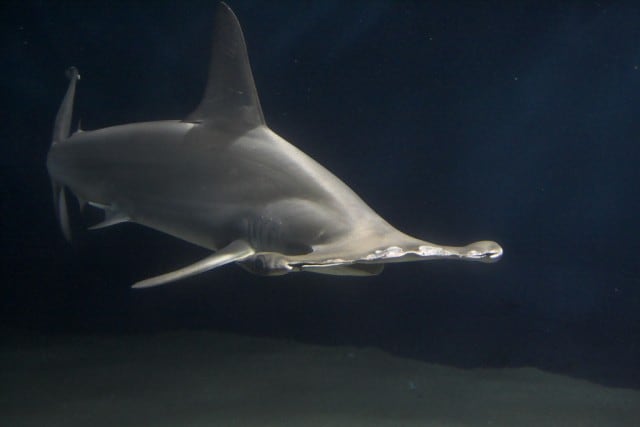
By suneko (Flickr) CC BY 2.0, via Wikimedia Commons
As Darwin discovered, the Galapagos Islands are the home for a number of species of marine and land animals that can be found nowhere else but here.
In this page you will find more detailed information about scuba diving in Galapagos.
Table of contents
Best Dive Review
Marine Life
The biggest attractions for most Scuba Divers is the vast marine life, there are over 400 species of fish of which 17% are only found in the Galapagos Islands. Hundreds of pelagic fish can be found on most dive sites.
Drift Dives
For the experienced drift diver, the Galapagos Islands especially those north of the central islands are a mecca for drifts. The currents are strong and can be challenging but brings an experience unmatched elsewhere.
How to dive Galapagos?
The Galapagos Islands offers divers a range of adventures based on what they want to experience and their skill levels.
Liveaboards
Most divers when they think of the Galapagos think liveaboard. While there are many excellent dive sites around the central islands, Wolf and Darwin Islands together form the area around which all Galapagos diving liveaboards head to. These islands are found in the far north-west of the Galapagos archipelago, 350 km from San Cristobal, the capital and principal city, in the central islands. The liveaboards range from 7 days to 10 days with a few special trips being longer.
The liveaboards travel at night offering diving during the day at islands and reefs along the way and again on the return. Due to the different ocean currents it is entirely possible for a diver to experience tropical waters and marine life on the first dive site of the day and temperate conditions at a second dive site a short distance away.
I usually use this website to book in advance my liveaboards in the Maldives as they usually have the lowest rates I find. I like it because they have an easy booking system.
This mixture of different currents from different temperature zones give Scuba Divers exposure to marine life that is not found together anywhere else in the world. The northern islands are known for their massive schools of fish. Hammerhead sharks can be seen in the hundreds. More than a dozen species of sharks as well as rays are found in these waters in numbers to high to count. Barracuda, tuna, dolphins, whales and other large marine life can be found on most dive sites. The coral growth produces some of the largest specimens in the world. Most of the year visibility seems unlimited. The times the visibility is poor is great too, as that is when the highest number of whale sharks can be found.
The different ocean current can impact a dive without notice and can be very strong at times. Due to this, the liveaboards will only accept experience divers, Divers who have experience diving in unpredictable conditions and wearing different exposure suits.
Central Island Resort
While not as well known as the liveaboards, the Galapagos Islands does have a number of outstanding dive centers and dive resorts. Divers around the central islands will also experience some of the same marine life, however, in much smaller numbers as those on the liveaboards. The central islands has dive sites suitable for beginners as well as those requiring more advanced skills. Open Water Diver training, advance Open Water and many specialties are available.
Best time to dive in Galapagos
Diving is available year round and the best time to dive in the Galapagos islands depends on what you want to do. The Galapagos Islands has two seasons: Wet and Dry. They vary slightly each year so there is no clear divide.
- January to June is wet season. The weather pattern is mostly sunny days interrupted with brief but intense rains. Air temperatures hover around 30°C, while the water temperatures generally is between 20-25°C. January to May has the calmest weather and seas and the greater occurrences of Hammerhead sharks and Manta Rays.
- Dry season known as “garua”, from July to December, sees less rain but cooler temperatures stating around 22°C. Water temperatures in dry season range around 17-20°C. Visibility is lower during this time, however, it is generally better that 15 to 20 meters. This poorer visibility is because of increased nutrients in the waters. This is the Peak Season as the nutrients increase attracts the migratory Whale Sharks. June to November are the peak months for the Whale Sharks.
Please note that water temperatures can vary greatly the closer you are to the currents. Also the Pacific weather pattern known as El Nino can cause major changes in the seasons
Top liveaboards in Galapagos according to divers reviews
Dive courses
The dive centers and dive resorts in the central island areas offer a full range of dive training. Open Water Diver courses are available. It is also a great location for Advance Open Water, Drift diving and Underwater Photography.
Scuba Diving conditions
Divers coming to dive the islands need to be prepared for changing conditions.
Visibility seldom gets very bad as 15 meters is considered poor visibility here. It is temperature changes due to currents that can cause the most variances. This is less of a concern around the Central Islands where dry season water temperatures stay near 20°C and wet season near 25°C.
In the northern areas visited by the Galapagos Liveaboards, the currents are the dominate force. Only experience divers should try these waters as the currents can be unpredictable and the unexperienced diver easily overcome by the currents.
Snorkelling in Galapagos
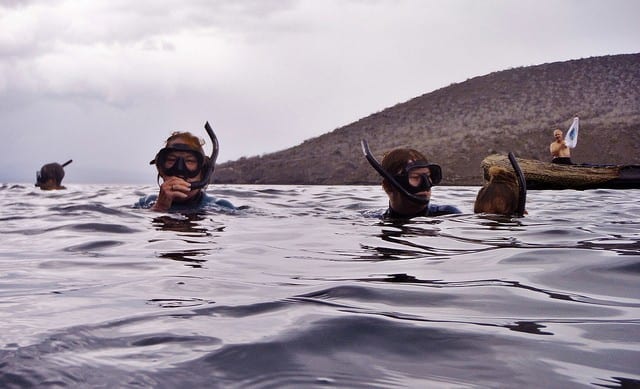
Snorkeling Galapagos Islands by pantxorama Creative commons
While the islands are known mostly for the diving it is also an outstanding destination for the snorkeler. Most of the snorkeling is done from boats but a few are shore dives. Nature lovers can take a nature liveaboard that are focused on the different islands and their fauna and wildlife. Most of these also include snorkeling in sheltered coves.
Fishes and Coral
As mentioned above, the Galapagos Islands has over 400 species of fish and the highest biomass in the world. It has species found in both tropical waters and temperate waters. There are 28 species of Sharks alone. The most common to see are:
- Blacktip sharks
- Scalloped hammerhead sharks
- Galapagos sharks
- White-tip reef sharks
- Whale Sharks (depending on the season)
Some other large fish commonly seen include:
- Barracuda
- Groupers
- Yellowfin tuna
- Jacks
- Snappers
Last but far from least are:
- Dolphins
- Whales
- Turtles
- Seal and sea lions
- Marine Iguanas
- Galapagos Penguins
Diving Safety
If you are planning an upcoming dive trip or travelling to Galapagos, it is a really good idea to invest in travel insurance for scuba diving, because you never know what could happen and when you might need it (because accidents do happen!). I recommend this diving insurance as they offer worldwide coverage and focus on providing scuba divers a quality insurance and medical assistance service.
Wolf and Darwin islands are the best place in the world to see hammerhead sharks as well as having the most marine life in one place in the world. For the experienced diver who loves marine life and current diving this is truly the best destination.
The Central islands are also an outstanding destination for Scuba Divers not quite ready for the far north. They offer most of the unique species seen north but without the thrill of the heavy seas and strong currents. Also the central islands allow visitors to explore both under the sea and on the land.
Photos Galapagos
Travel Guide
Now that you know all about the underwater world, you might want to start planning your scuba holiday! Check out our Galapagos Travel Review for information about how to get there, activities and excursions, where to stay, and more.

Diving Reviews for this region
Dive spots reviews in Galapagos
Liveaboard Reviews in Galapagos
MV Majestic Explorer
UPDATE JUNE 2019 We had this update than
MV Galapagos Aggressor III
Ubiquitous with international liveboard
MV Humboldt Explorer
Explorer Adventures are one of a limited
 Destinations
Destinations



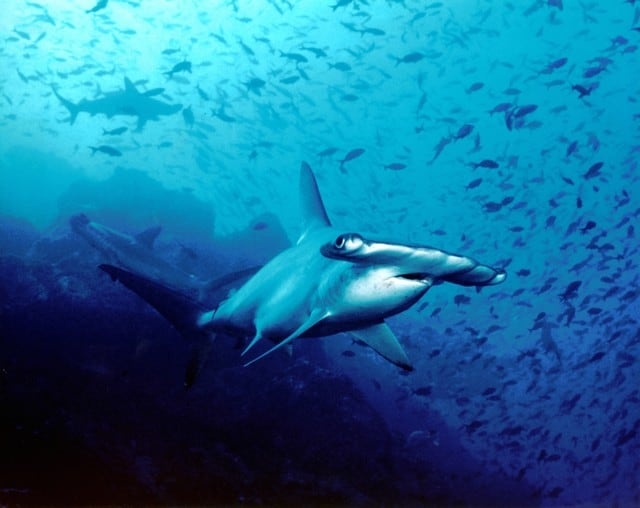
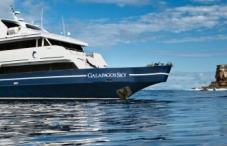






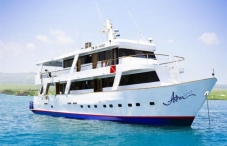

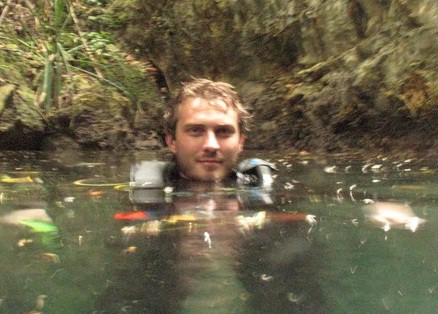




The Galapagos Islands are simply just as good as everybody says. Look no further.
The Astrea liveaboard, great on all point. Nothing is cheap about their service. From the first e-mail to the last hand shake = AMAZING. Again, look no further.
I have dived lots of liverboard in all other contents this is the most amazing place i have ever been
I have been to Galapagos on four liveaboard dive trips; 2006, 2007, 2008, and 2012. Unfortunately, two of the boats, Deep Blue and Darwin Buddy, are no longer operational. They were both excellent operations and really nice boats. The 2007 trip was with Aggressor and I can’t say enough good things about Aggressor! In fact, I am leaving in a few days to dive Cocos Island on one of the Aggressor boats!
Galapagos diving is AMAZING!!! I would visit every year if I could! I have only been there in the summer, June, July, and August, but from what I saw on these trips, I can’t imagine anything better. The amount of life is INSANE! Whale sharks, Galapagos sharks, hammerheads, Silkies, white tip reef sharks, and bull sharks on one of the trips! We also saw horn sharks of Isabella! Manta rays, spotted eagle rays, marble rays, and mobula rays. Dolphins, sea lions, turtles, marine iguanas, flightless cormorants, and large moray eels! Yellowfin tuna, jacks, barracuda, moorish idols, king angelfish, and many more!
Darwin and Wolf Islands are the best diving spots, and can only be reached by liveaboard. These are also the warmest water temps, mid 70s. Isabella and Cousins Rock are great southern dive sites, but colder with low to mid 60s.
Can’t wait to get back to my favorite dive destination! Hopefully, Cocos will become a new favorite!